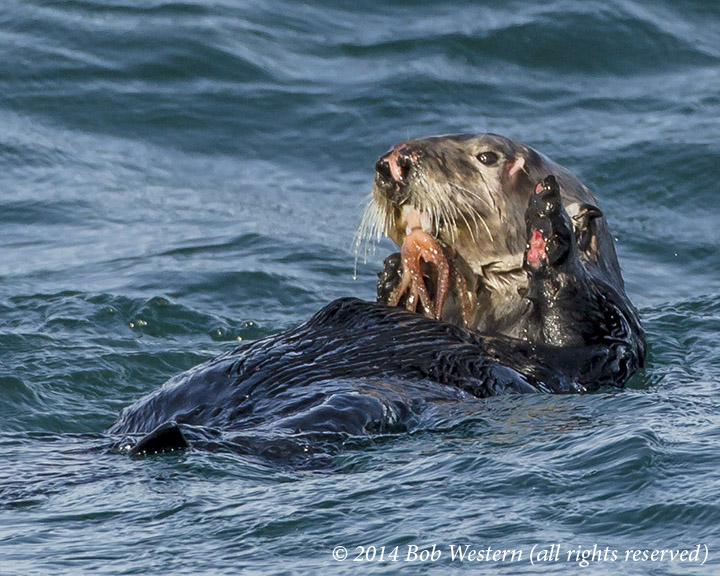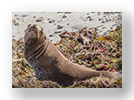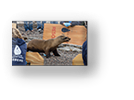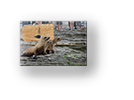






































A female Southern Sea Otter, Enhydra lutris nereis, with a cut behind it's left eye, and severe damage to it's left paw, causing partial detachment of the fleshy foot pad, evidence of sharp force trauma, possibly from a boat propeller, or even shark teeth. An unusal dark mark across the top of her head makes a boat strike the likely culprit. See Special note #3.
A female Southern Sea Otter, Enhydra lutris nereis, with a cut behind it's left eye, and severe damage to it's left paw, causing partial detachment of the fleshy foot pad, evidence of sharp force trauma, possibly from a boat propeller, or even shark teeth. An unusal dark mark across the top of her head makes a boat strike the likely culprit. See Special note #3.
A female Southern Sea Otter, Enhydra lutris nereis, with a cut behind it's left eye, and severe damage to it's left paw, causing partial detachment of the fleshy foot pad, evidence of sharp force trauma, possibly from a boat propeller, or shark teeth.
Fishing line wrapped around the neck of a California Sea Lion, Zalophus californianus. This is one of the most common human caused injuries to marine mammals. As they grow, the line cuts deeper into the flesh, eventually causing complete separation of the epidermis, and exposing the blubber layer. See Special note #2.
Fishing line wrapped around the neck of a California Sea Lion, Zalophus californianus, has cut deep into the flesh, and exposing the blubber layer. See Special note #2.
Fishing line wrapped around the neck of a California Sea Lion, Zalophus californianus, has cut deep into the flesh, and exposed the blubber layer. You can see the line snaking along the bottom of the cut. See Special note #2.
A cut across the back of a California Sea Lion, Zalophus californianus, caused by a boat strike.
A bite on the neck of a California Sea Lion, Zalophus californianus, has small triangular shaped cuts around the edges, which may have been caused by a small shark. The nasal discharge could mean it has a respiratory, or systemic infection.
A Brandt's cormorant, Phalacrocorax penicillatus, with a fish hook through it's cheek. Cormorants swim through kelp forests, where fishing gear has been lost, and may become fouled, or they may attempt to eat a baited hook. They sometimes fly into a cast fishing line. See special note #4.
A juvenile Brandt's cormorant that took this bait, hook, line, and sinker.
This Brandt's cormorant, Phalacrocorax penicillatus, swallowed the hook, and is fouled with line and the sinker.
A Brandt's cormorant, Phalacrocorax penicillatus, with a fish hook through it's beak. Although this braided dacron line will last for many years in sea water, some monofiliment fishing line takes over 600 years to breakdown. Stainless steel fish hooks will last for decades, or longer. See Special note #5.
California Sea Lions, Zalophus californianus, rarely haul out on beaches around Monterey Bay. It can be a sign of sickness, when they do. Under no circumstances should they be approached by humans, or pets. Instead they should be reported to the Marine Mammal Center (415-289-SEAL.)
A Harbor Seal, Phoca vitulina, that a few years before was attacked by a Great White shark. The horrific injury has partially healed, but scar tissue has puckered the wound. This female has gone on to have multiple pups, since the attack, she was photographed in Monterey, near Fisherman's Wharf, CA.
A Harbor Seal, Phoca vitulina, that a few years before was attacked by a Great White shark. The horrific injury has partially healed, but scar tissue has puckered the wound. This female has gone on to have multiple pups, since the attack, she was photographed in Monterey, near Fisherman's Wharf, CA.
This California Sea Lion tore his way loose from a fishing net, but carries parts of the net with him. It is wrapped around his neck in two places. He is still too strong and hangs out in areas where it would be too dangerous to try a rescue. He'll need to get weaker before it is possible to bring him in to the Marine Mammal Center.
This California sea lion was cut opened by a sharp, very precise object, probably a boat propeller. The cut was through the blubber layer and into muscle tissue.
A Harbor Seal, Phoca vitulina, fouled by fishing line behind the eyes and around the middle.
Harbor Seal, Phoca vitulina, with fishing line draped over it's head. The line was wrapped aroung the head and body. Near Fisherman's Wharf, Monterey, CA.
An abscess is a pocket of infection. The bacteria can dissolve the tissue, causing an open sore. This may have started as a puncture wound, from a fight with another sea lion, or a deep scratch from climbing rocks. This will probably heal on its own, since sea water acts as an antibiotic, killing many pathogenic bacteria.
This Brandt's cormorant, Phalacrocorax penicillatus, swallowed the hook attached to this fishing rig.
A Brandt's cormorant, Phalacrocorax penicillatus, that swallowed a hook, and can become trapped if the attached line becomes stuck to the rocks, or wrapped around it's body and wings.
A festering wound on the neck of a California Sea Lion, Zalophus californianus, caused by fishing line.
Plastic straps, used on boxes and shipping containers, are another common source of fouling among marine mammals.
Some of the thousands of feet of fishline that remains in the environment at just one pier in Monterey Bay. See Special note #4.
A feathered fishing lure, with a stainless steel hook, fouling a Brown Pelican, Pelecanus occidentalis.
A prolapse of the tear duct of this California Sea Lion, Zalophus californianus, has caused the tissue to cover the eyeball. Although not directly fatal, it could limit it's ability to hunt or evade predators. This condition may have been caused by a blow to the eye, possibly from a fight with another sea lion.
A California Sea Lion, Zalophus californianus, with an unkown, eventually fatal, injury. The flesh was torn away from the body by a pretty strong force, but I couldn't see enough of the injury to determine a cause.
A seriously injured California Sea Lion, Zalophus californianus, hauled out at the boat ramp in Monterey, near the Coast Guard Breakwater. This animal was in the area for a number of days before it was weak enough to rescue. It evaded all previous attempts to capture it.
A rescue team from the Marine Mammal Center netted the animal. See Special note #1.
Once the sea lion is netted, the rest of team moves in to secure it.
Boards are used to drive the animal into the carrier, while protecting the rescuers. Once in the carrier the animal was transported to a holding facility in Moss Landing, then driven to the Marine Mammal Center headquarters and medical facility in Sausalito, CA. This sea lion died from its wounds, despite the best efforts of this team of trained volunteers.
On May 8, 2015 six sea lions that were rescued by the Marine Mammal Center were released on Weston beach in Pt. Lobos State Reserve, south of Carmel, CA. Families of volunteers and supporters look on.
Sea lions released by the Marine Mammal Center, after medical treatment, run a gauntlet of volunteers that are placed to keep them focused on the ocean. The animals were tagged to keep track of where they go from here.
Rescued sea lions are released to the wild as onlookers cheer the release.
Released sea lions move past supporters of the Marine Mammal Center and head for the water on Weston beach, Pt. Lobos State Reserve.
These three sea lions, recently released by the Marine Mammal Center after various medical treatments, were in no hurry to reach the water.
Recently released sea lions look back at their rescuers before they reach the water. Maybe hoping for one last free fish.
The rescued sea lions swim off to the open ocean off Weston beach, Pt. Lobos State Reserve, south of Carmel, CA.
<
>
The Coast Guard Breakwater, in Monterey, was built in the early thirties. Monofiliment fishing line was introduced in the late thirties. All nylon fishing line lost since then may still be in the environment.
Each year 600 to 800 marine mammals are rescued, and most are successfully returned to the wild. In 2015 the lack of food in southern California waters drove sea lion females and pups, that normaly stay south to feed, into Monterey Bay. A number of females aborted their fetuses, and many pups were starving. Over 1500 marine mammals were rescued, just in the first few months of the year.
Untreated this is a very painful and gruesome way to die. An animal can be fouled like this for years, before it succumbs, or gets sick enough to come ashore and hopefully rescued.
Although not severe enough to prevent the animal from catching an octopus, it would impair it's ability to feed on crabs, urchins and mussels. Equally vital, this injury makes grooming difficult. Sea Otter fur must be kept clean to keep the animal warm. They lack an insulating blubber layer, like seals and sea lions. A fouled coat can be fatal to sea otters.
Some cormorants use fishing line as nesting material. The line becomes cemented into the nest by bird droppings, then the adults or the chicks become fouled and cannot free themselves from the nest.They will starve to death, or are unable to evade predators.
A
B
C
D
E
1
2
3
4
5
6
7
8
Special note #1
Special note #2
Special note #3
Special note #4
Injured Marine Animals
Click on thumbnails to delay slide show for 15 seconds. Use arrow keys (below) for navigation.
Special note #5
This website contains graphic images of injured marine animals. Sensitive viewers should use the menu list above to navigate to a different page. Otherwise click here to enter the site.
ALL IMAGES ON THIS SITE ARE © 2011, 2013, 2014, 2015 BOB WESTERN (ALL RIGHTS RESERVED AND GUARDED VIA INVISIBLE WATER MARKS AND SPIDER TRACKING
EMAIL FINEART@BOBWESTERN.COM FOR PERMISSION TO USE AN IMAGE. THANK YOU FOR YOUR CONSIDERATION.














